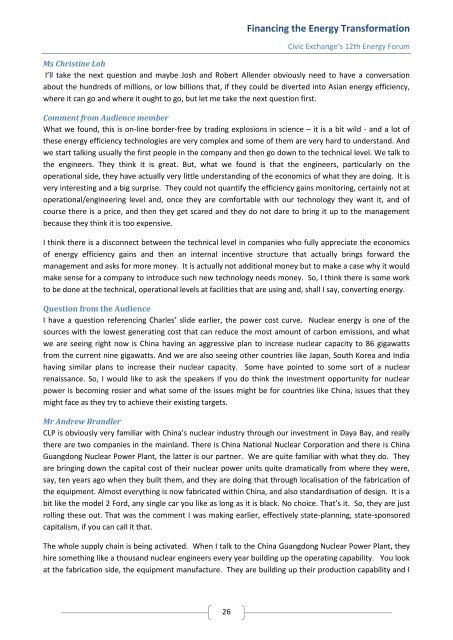Financing the Energy Transformation - Civic Exchange
Financing the Energy Transformation - Civic Exchange
Financing the Energy Transformation - Civic Exchange
You also want an ePaper? Increase the reach of your titles
YUMPU automatically turns print PDFs into web optimized ePapers that Google loves.
<strong>Financing</strong> <strong>the</strong> <strong>Energy</strong> <strong>Transformation</strong><strong>Civic</strong> <strong>Exchange</strong>’s 12th <strong>Energy</strong> ForumMs Christine LohI’ll take <strong>the</strong> next question and maybe Josh and Robert Allender obviously need to have a conversationabout <strong>the</strong> hundreds of millions, or low billions that, if <strong>the</strong>y could be diverted into Asian energy efficiency,where it can go and where it ought to go, but let me take <strong>the</strong> next question first.Comment from Audience memberWhat we found, this is on-line border-free by trading explosions in science – it is a bit wild - and a lot of<strong>the</strong>se energy efficiency technologies are very complex and some of <strong>the</strong>m are very hard to understand. Andwe start talking usually <strong>the</strong> first people in <strong>the</strong> company and <strong>the</strong>n go down to <strong>the</strong> technical level. We talk to<strong>the</strong> engineers. They think it is great. But, what we found is that <strong>the</strong> engineers, particularly on <strong>the</strong>operational side, <strong>the</strong>y have actually very little understanding of <strong>the</strong> economics of what <strong>the</strong>y are doing. It isvery interesting and a big surprise. They could not quantify <strong>the</strong> efficiency gains monitoring, certainly not atoperational/engineering level and, once <strong>the</strong>y are comfortable with our technology <strong>the</strong>y want it, and ofcourse <strong>the</strong>re is a price, and <strong>the</strong>n <strong>the</strong>y get scared and <strong>the</strong>y do not dare to bring it up to <strong>the</strong> managementbecause <strong>the</strong>y think it is too expensive.I think <strong>the</strong>re is a disconnect between <strong>the</strong> technical level in companies who fully appreciate <strong>the</strong> economicsof energy efficiency gains and <strong>the</strong>n an internal incentive structure that actually brings forward <strong>the</strong>management and asks for more money. It is actually not additional money but to make a case why it wouldmake sense for a company to introduce such new technology needs money. So, I think <strong>the</strong>re is some workto be done at <strong>the</strong> technical, operational levels at facilities that are using and, shall I say, converting energy.Question from <strong>the</strong> AudienceI have a question referencing Charles’ slide earlier, <strong>the</strong> power cost curve. Nuclear energy is one of <strong>the</strong>sources with <strong>the</strong> lowest generating cost that can reduce <strong>the</strong> most amount of carbon emissions, and whatwe are seeing right now is China having an aggressive plan to increase nuclear capacity to 86 gigawattsfrom <strong>the</strong> current nine gigawatts. And we are also seeing o<strong>the</strong>r countries like Japan, South Korea and Indiahaving similar plans to increase <strong>the</strong>ir nuclear capacity. Some have pointed to some sort of a nuclearrenaissance. So, I would like to ask <strong>the</strong> speakers if you do think <strong>the</strong> investment opportunity for nuclearpower is becoming rosier and what some of <strong>the</strong> issues might be for countries like China, issues that <strong>the</strong>ymight face as <strong>the</strong>y try to achieve <strong>the</strong>ir existing targets.Mr Andrew BrandlerCLP is obviously very familiar with China’s nuclear industry through our investment in Daya Bay, and really<strong>the</strong>re are two companies in <strong>the</strong> mainland. There is China National Nuclear Corporation and <strong>the</strong>re is ChinaGuangdong Nuclear Power Plant, <strong>the</strong> latter is our partner. We are quite familiar with what <strong>the</strong>y do. Theyare bringing down <strong>the</strong> capital cost of <strong>the</strong>ir nuclear power units quite dramatically from where <strong>the</strong>y were,say, ten years ago when <strong>the</strong>y built <strong>the</strong>m, and <strong>the</strong>y are doing that through localisation of <strong>the</strong> fabrication of<strong>the</strong> equipment. Almost everything is now fabricated within China, and also standardisation of design. It is abit like <strong>the</strong> model 2 Ford, any single car you like as long as it is black. No choice. That’s it. So, <strong>the</strong>y are justrolling <strong>the</strong>se out. That was <strong>the</strong> comment I was making earlier, effectively state-planning, state-sponsoredcapitalism, if you can call it that.The whole supply chain is being activated. When I talk to <strong>the</strong> China Guangdong Nuclear Power Plant, <strong>the</strong>yhire something like a thousand nuclear engineers every year building up <strong>the</strong> operating capability. You lookat <strong>the</strong> fabrication side, <strong>the</strong> equipment manufacture. They are building up <strong>the</strong>ir production capability and I26
















